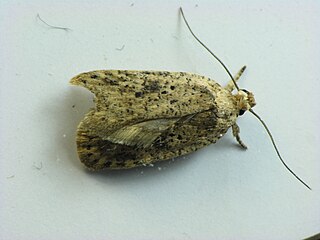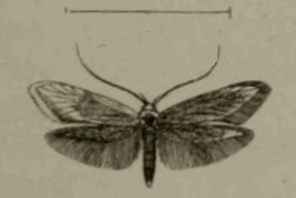
The Elachistidae are a family of small moths in the superfamily Gelechioidea. Some authors lump about 3,300 species in eight subfamilies here, but this arrangement almost certainly results in a massively paraphyletic and completely unnatural assemblage, united merely by symplesiomorphies retained from the first gelechioid moths.

The Gelechiidae are a family of moths commonly referred to as twirler moths or gelechiid moths. They are the namesake family of the huge and little-studied superfamily Gelechioidea, and the family's taxonomy has been subject to considerable dispute. These are generally very small moths with narrow, fringed wings. The larvae of most species feed internally on various parts of their host plants, sometimes causing galls. Douglas-fir (Pseudotsuga) is a host plant common to many species of the family, particularly of the genus Chionodes, which as a result is more diverse in North America than usual for Gelechioidea.

Gelechioidea is the superfamily of moths that contains the case-bearers, twirler moths, and relatives, also simply called curved-horn moths or gelechioid moths. It is a large and poorly understood '"micromoth" superfamily, constituting one of the basal lineages of the Ditrysia.

The Batrachedridae are a small family of tiny moths. These are small, slender moths which rest with their wings wrapped tightly around their bodies.
The Cosmopterigidae are a family of insects in the order Lepidoptera. These are small moths with narrow wings whose tiny larvae feed internally on the leaves, seeds and stems of their host plants. About 1500 species are described. The taxonomic family is most diverse in the Australian and Pacific region with about 780 species.

Pterolonchidae is a small family of very small moths in the superfamily Gelechioidea. There are species native to every continent except Australia and Antarctica.

The insect order Lepidoptera consists of moths, most of which are night-flying, and a derived group, mainly day-flying, called butterflies. Within Lepidoptera as a whole, the groups listed below before Glossata contain a few basal families accounting for less than 200 species; the bulk of Lepidoptera are in the Glossata. Similarly, within the Glossata, there are a few basal groups listed first, with the bulk of species in the Heteroneura. Basal groups within Heteroneura cannot be defined with as much confidence, as there are still some disputes concerning the proper relations among these groups. At the family level, however, most groups are well defined, and the families are commonly used by hobbyists and scientists alike.

Homaledra is a small genus of at least four species small moth of the family Pterolonchidae native to North and South America.

Depressariidae is a family of moths. It was formerly treated as a subfamily of Gelechiidae, but is now recognised as a separate family, comprising about 2,300 species worldwide.

Stephensia is a genus of the small and very small moths of the family Elachistidae.

Perittia is a genus of moths of the family Elachistidae.
Coelopoeta glutinosi is a tiny species of moth in the superfamily Gelechioidea. It is found in California in the United States.
Coelopoeta phaceliae is a moth in the superfamily Gelechioidea. It is found in the US state of California.
Coelopoeta maiadella is a moth in the superfamily Gelechioidea. It is found in Yukon, Canada.

Syringopais temperatella, the cereal leaf miner or wheat leaf miner, is a very small sized moth of the family Pterolonchidae. It is found on Cyprus and in Greece and the Near East. It is an important pest in cereal grain fields in some areas.

Homaledra heptathalama, the exclamation moth or palm leaf housemaker, is a moth in the family Pterolonchidae. It was described by August Busck in 1900. It is found in the United States, where it has been recorded from Alabama, Florida and South Carolina.
Homaledra sabalella, the palm leaf skeletonizer moth, is a moth in the family Pterolonchidae. It is found in North America, where it has been recorded from Alabama, Florida, Mississippi, South Carolina and Texas. It is also present in Puerto Rico, Hispaniola and Cuba.
Epimarptidae was a former, or is a possible, monotypic family of moths in the moth superfamily Gelechioidea. It can now be seen as either a synonym of family Batrachedridae, or a monotypic subfamily of that family.

Mathildana is a genus of concealer moths in the family Oecophoridae. There are at least three described species in Mathildana.

Pterolonche is small genus of small moths of the family Pterolonchidae.










